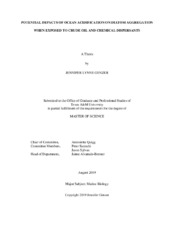| dc.description.abstract | Ocean acidification (OA) and its effects on seawater carbonate chemistry will affect all marine organisms, especially those that utilize inorganic carbon for photosynthesis. Diatoms, a group of silicifying phytoplankton, play a key role in the marine carbon cycle due to their high primary productivity rates, worldwide distribution, and production of extracellular polymeric substances (EPS). These exudates lead to marine snow formation that rapidly transports organic material to the seafloor. Diatoms also produce EPS for protection from harmful substances, such as oil spills. The effects of oil compounds on phytoplankton in future OA conditions has not been well studied. Roller table experiments with Thalassiosira pseudonana, a small centric diatom, were conducted to produce marine snow aggregates in six treatments: Control (pCOv2 = 400 ppm), OA (pCOv2 = 750 ppm), water accommodated fraction of oil (WAF), OAWAF, diluted chemically enhanced WAF (DCEWAF), and OADCEWAF. Measurements included photophysiological responses, oil concentrations, aggregate morphology, and exudate production to investigate if OA will affect the response to oil spill conditions. Marine snow and marine oil snow (MOS) formed in all treatments, but to varying sizes and amounts. The WAF and DCEWAF treatments simulating two spill conditions induced varying responses from T. pseudonana. WAF and OAWAF aggregates had less total area and accumulated more PAHs from the surrounding seawater (SSW), but DCEWAF and OADCEWAF aggregates incorporated a higher relative amount of polycyclic aromatic hydrocarbons (PAHs) based on the initial concentrations. Additionally, transparent exopolymeric particles (TEP) and EPS production increased in presence of petroleum compounds. Larger aggregates formed in OA, OAWAF and OADCEWAF compared to their current day counterparts, subsequently capturing more cells and oil compounds.
The cell accumulation within aggregates was similar between the stationary and exponential growth phase experiments, but the pre-existing concentrations of exudates from the culture were what most likely affected the distinctive aggregate formations. Based on the aggregate area and morphology, it was determined that OA affected aggregate formations, and subsequently may affect the biological carbon pump. The findings of this study will inform first responders as they plan to address future oil spills. | en |


